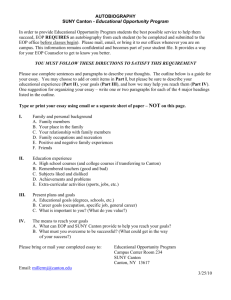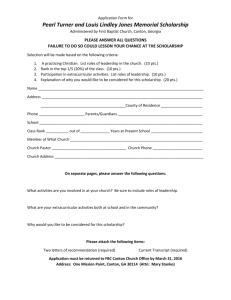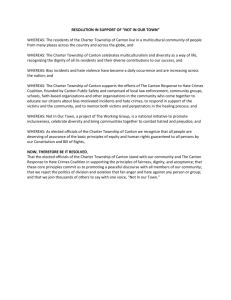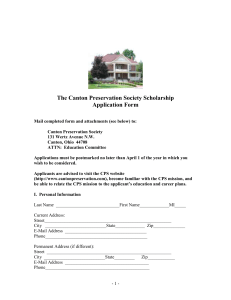Shameen: A Colonial Heritage
advertisement
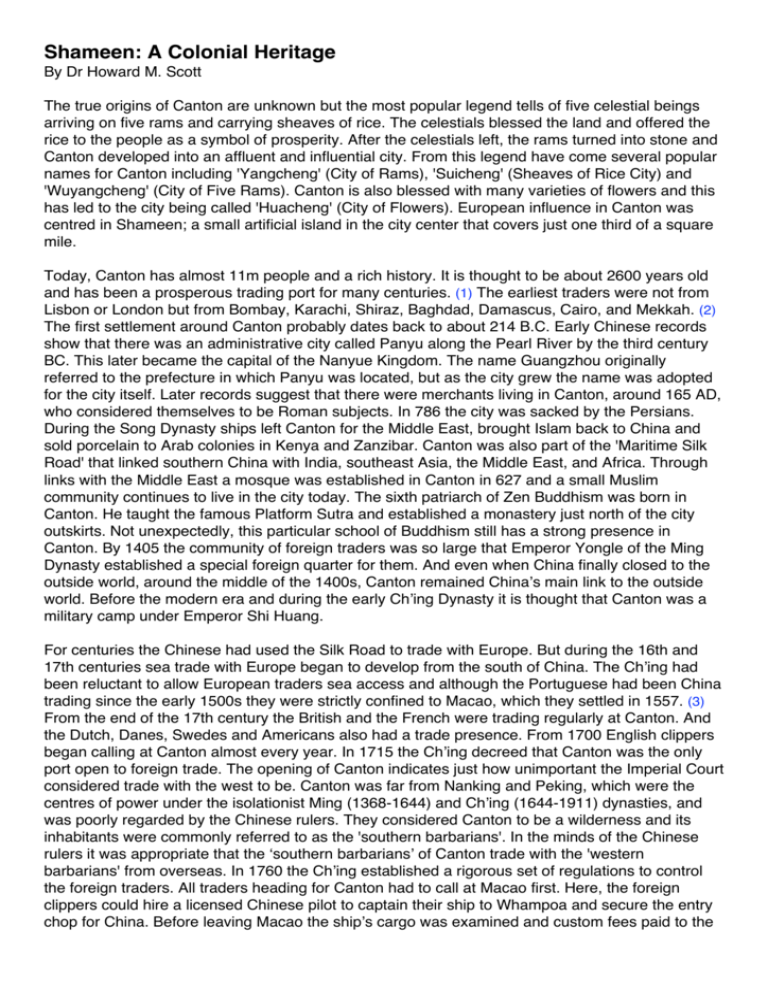
Shameen: A Colonial Heritage By Dr Howard M. Scott The true origins of Canton are unknown but the most popular legend tells of five celestial beings arriving on five rams and carrying sheaves of rice. The celestials blessed the land and offered the rice to the people as a symbol of prosperity. After the celestials left, the rams turned into stone and Canton developed into an affluent and influential city. From this legend have come several popular names for Canton including 'Yangcheng' (City of Rams), 'Suicheng' (Sheaves of Rice City) and 'Wuyangcheng' (City of Five Rams). Canton is also blessed with many varieties of flowers and this has led to the city being called 'Huacheng' (City of Flowers). European influence in Canton was centred in Shameen; a small artificial island in the city center that covers just one third of a square mile. Today, Canton has almost 11m people and a rich history. It is thought to be about 2600 years old and has been a prosperous trading port for many centuries. (1) The earliest traders were not from Lisbon or London but from Bombay, Karachi, Shiraz, Baghdad, Damascus, Cairo, and Mekkah. (2) The first settlement around Canton probably dates back to about 214 B.C. Early Chinese records show that there was an administrative city called Panyu along the Pearl River by the third century BC. This later became the capital of the Nanyue Kingdom. The name Guangzhou originally referred to the prefecture in which Panyu was located, but as the city grew the name was adopted for the city itself. Later records suggest that there were merchants living in Canton, around 165 AD, who considered themselves to be Roman subjects. In 786 the city was sacked by the Persians. During the Song Dynasty ships left Canton for the Middle East, brought Islam back to China and sold porcelain to Arab colonies in Kenya and Zanzibar. Canton was also part of the 'Maritime Silk Road' that linked southern China with India, southeast Asia, the Middle East, and Africa. Through links with the Middle East a mosque was established in Canton in 627 and a small Muslim community continues to live in the city today. The sixth patriarch of Zen Buddhism was born in Canton. He taught the famous Platform Sutra and established a monastery just north of the city outskirts. Not unexpectedly, this particular school of Buddhism still has a strong presence in Canton. By 1405 the community of foreign traders was so large that Emperor Yongle of the Ming Dynasty established a special foreign quarter for them. And even when China finally closed to the outside world, around the middle of the 1400s, Canton remained China’s main link to the outside world. Before the modern era and during the early Ch’ing Dynasty it is thought that Canton was a military camp under Emperor Shi Huang. For centuries the Chinese had used the Silk Road to trade with Europe. But during the 16th and 17th centuries sea trade with Europe began to develop from the south of China. The Ch’ing had been reluctant to allow European traders sea access and although the Portuguese had been China trading since the early 1500s they were strictly confined to Macao, which they settled in 1557. (3) From the end of the 17th century the British and the French were trading regularly at Canton. And the Dutch, Danes, Swedes and Americans also had a trade presence. From 1700 English clippers began calling at Canton almost every year. In 1715 the Ch’ing decreed that Canton was the only port open to foreign trade. The opening of Canton indicates just how unimportant the Imperial Court considered trade with the west to be. Canton was far from Nanking and Peking, which were the centres of power under the isolationist Ming (1368-1644) and Ch’ing (1644-1911) dynasties, and was poorly regarded by the Chinese rulers. They considered Canton to be a wilderness and its inhabitants were commonly referred to as the 'southern barbarians'. In the minds of the Chinese rulers it was appropriate that the ‘southern barbarians’ of Canton trade with the 'western barbarians' from overseas. In 1760 the Ch’ing established a rigorous set of regulations to control the foreign traders. All traders heading for Canton had to call at Macao first. Here, the foreign clippers could hire a licensed Chinese pilot to captain their ship to Whampoa and secure the entry chop for China. Before leaving Macao the ship’s cargo was examined and custom fees paid to the Hoppo, the head of the Imperial Board of Revenue and who resided in Canton. (4) Then the pilot was free to proceed up the Pearl River to Whampoa Island, just 13 miles south of Canton. But the foreign clippers could not go beyond Whampoa where up to a hundred ships often remained at anchor under the supervision of the Chinese fort. Sailors had to remain with their ship and could only enter Canton with special permission and in the company of a ship’s officer. Although European captains could go on to Canton during the trading season, foreign women and guns were prohibited. Any foreign women on the China coast had to remain in Macao and in Canton there were regulations confining foreigners to the row of factories set up outside the city and along the banks of the Pearl River. These long narrow buildings stored goods on the first floor, had offices on the second floor and provided accommodation on the third. The factories were named by the country that first established them and had names like Sweden, Denmark, and Austria. The factories were more commonly called by the Portuguese term, ‘godowns’. The Imperial authorities controlled all foreign trade to ensure that taxes on trade went into the Chíing exchequer. Peking appointed an official known as the Hoppo who worked closely with a limited number of government approved wholesalers known as the Hong merchants. European purchases had to be made through the Hong Guild and no single co-hong merchant was allowed to provide more than half of any ship's cargo. Chinese interpreters handled the negotiations in Portuguese and later in pidgin, which came to be known locally as ‘port lingo’. The co-hongs were also responsible for the good behavior of the foreigners with whom they traded. This rigid and formal trading system came to be known as ‘The Canton System’ and as the China trade in Canton flourished English traders were joined by French, Dutch, Austrian, Danish and Swedish merchants. After 1784, ships from India and the Americas joined the traders from Europe. Several of the early China traders, such as Russell, Perkins, Heard and Olyphant became very wealthy through their silk, tea and porcelain trading. The modern era began in the early eighteenth century when the British East India Company, in 1711, used Canton as their base to purchase Chinese silk, ceramics and tea. By the late eighteenth century tea purchases dominated the China trade and accounted for more than 60 percent of the East India Company’s purchases. The Imperial Chinese authorities required all purchases to be made in silver. With English silver increasingly in short supply, European traders began to bring Indian opium to China, which they sold for Chinese silver dollars and then used the silver dollars to finance their purchases of tea. Meanwhile the English traders were becoming dissatisfied with the services available to them from Macao and the Ch’ing were becoming increasingly nervous about the growing European presence in Canton and the spiraling opium trade. In 1796 an edict totally banning the drug trade was issued but was ignored by the foreign traders. As the trading environment in Canton deteriorated, Lintin Island developed as the preferred transit point for the European clippers bringing opium to China. Lintin Island, lying in the mouth of the Pearl River Estuary northwest of Lantau Island and northeast of Macao, was known as the ‘outer anchorage’. Being in the outer waters of the estuary it was beyond the jurisdiction of both the Chinese and Portuguese authorities yet within easy reach of the Bocca Tigris and the river passage to Canton. Ships bound for Canton would wait at Lintin for their cargo to be measured and for their Imperial custom fees to be collected. They also unloaded their opium here. But the lack of shelter during the monsoon season made the anchorage perilous and the sheltered harbour of Hong Kong to the southeast looked increasingly attractive to the opium clippers, schooners, sloops-of-war, barquentines and brigantines on the China coast. From 1821, as the Ch’ing prohibited the importation of opium into Macao and Whampoa, hulks were anchored at Lintin as floating depots and warehouses for the inbound opium cargoes. Chinese smugglers would then carry the opium to Canton and other ports in smaller boats. Once the opium had been offloaded at Lintin the clippers would continue on to Whampoa to unload their legal cargo and purchase tea. By the 1830s Lintin had become the trading base for the British in Southern China When the China traders left Lintin Island for Canton they had to pass through The Bogue. The Bogue, also known as the Bocca Tigris, was a heavily protected stretch of narrow water about 15 miles south of Canton running from Tai Ping to the junction of the East and Pearl rivers. On the western side there were batteries on Tycocktow Island and on the smaller islands of North and South Wangtong. And on the Eastern bank there were fortifications at Chuenpee, Anson Bay and Anunghoy. There was also a massive chain stretching across the river at Anunghoy to Chain Rock near South Wangtong Island. The Ch’ing regarded these fortifications as virtually impregnable for any aggressor hoping to pass through to the upper reaches of the Pearl River estuary and Canton. It was not until ‘The Opium Wars’ that the defenses of The Bogue were shown to be ineffective against European navies and their modern weapons. (5) After passing through the fortified Bogue the European traders reached Whampoa Island where they were required to anchor. Between Whampoa and Canton there were four more forts guarding access to the city. With their ships anchored at Whampoa the captains would proceed to Canton where the co-hongs would arrange their purchases of silk, tea, ceramics and lacquer-ware. But the European traders were not allowed to cross the city walls although they could visit Honan Island for recreation. Their stay in the godowns was limited to the trading season and they had to leave Canton for Macao as soon as their ships were loaded. The clippers, anchored downstream at Whampoa, were required to deposit their guns and powder with the Chinese authorities for safe custody. The traders grudgingly accepted these numerous restrictions, as the profits on their China trade were substantial. (6) By 1773 the British East India Company had established a company house in Macao, which they occupied during the non-trading months, giving the company a permanent presence close to Canton. (7) In 1839, as the Imperial stocks of silver continued to decline due to escalating opium purchases, Tao-kuang, Emperor of the Ch’ing, sent Commissioner Lin Tse-hsü to Canton with a mandate to eradicate opium use in China. The Emperor’s son had died from opium addiction and Lin, realizing the seriousness of his appointment, confined foreigners to their quarters on Shameen sandbank. He demanded that all opium stocks be handed over to him and then he publicly destroyed them. This, in conjunction with the ‘Kowloon Incident’, resulted in Britain declaring war on China. The Royal Navy, supported with funding from the opium-traders, forced the Ch’ing Dynasty to open five ports to foreign trade under the infamous Treaty of Nanking of 1842. The Treaty also ceded Hong Kong ‘in perpetuity’ to Britain, gave Europeans the right to reside in Canton and elsewhere along the China coast and established the principle of extra-territoriality and the legality of International Settlements in China. (8) Conditions changed drastically after the Opium Wars of 1839-41 and 1856-1860. (9) European traders gained access to numerous Chinese ports with rights of residence. Hong Kong had been ceded to Britain in 1842 and Shameen was leased to Britain in 1859. This period, known as ‘Extraterritoriality’, saw the European powers competing for influence by extending their respective privileges in China. The French, in the Treaty of Huangpu and the Americans in the Treaty of Wangxia inserted clauses allowing for the renegotiation of their treaties after a period of years. And Britain endeavoured to extend their privileges by demanding, in 1854, that the Ch’ing renegotiate the 1842 Treaty of Nanking. The extended privileges that the British sought were based on their ‘most favoured nation status’ and included opening all of China to British merchants, legalizing the opium trade, exempting foreign imports from internal Chinese taxes, committing the Ch’ing to the suppression of piracy, regulating the coolie trade, and appointing a British ambassador to Peking. Further, the English-language version of Treaties took precedence over the Chinese text. Shameen, now known as Shamian, was not a real island. In the 1840s it was a sandbank off the northern face of the Pearl River’s ‘White Goose Pond’ in downtown Canton. It was commonly known as Zhongliusha or Shicuizhou. Once leased to Britain it was reclaimed and the British, along with the French, turned Shameen into a Foreign Concession for European traders resident in Canton. After the Arrow War they reinforced the outer sandbank with stone retaining walls and from 1859-62 dug a canal on the northern side between North Shameen Street and the city. (10) The canal soon had many houseboats moored stem and stern, providing the International Settlement with provisions and services that included bordellos known as ‘flower boats’. In 1861 the British built the Western Stone Bridge to link Shameen to Canton and like all the main streets of the city, the bridge had an iron gate that closed at 10pm each night. Soon Consulates, warehouses, banks, offices and private colonial style homes covered the island. Business was brisk and the negotiations for tea, silk, and porcelain were carried out by firms such as Jardine, Matheson and Co., Dents and Deacons in the splendid company houses and shaded gardens throughout the island. So it was that trade and war established the International Settlement of Shameen. Once open to foreign influence, Canton rapidly became a center for active revolutionaries. During the late 1840s the Christian convert Hong Xiuquan planned his anti-Manchu Taiping Uprising from Canton and sixty years later Sun Yat-sen’s attempt to topple the Ch’ing Dynasty was executed from Canton. The city briefly became Sun's Kuo Min-tang capital in the 1920s and both Mao Tsetung and Chou En-lai spent much of their time in the city during the earliest days of the Chinese civil war. In the 1920s the Kuo Min-tang and the Communist Party were allies sending militia into the countryside against troublesome warlords during the Eastern and Northern Expeditions. Many later died during the 1927 Shanghai Massacre and the suppression of the Communists by Chiang Kai-shek. Japan began seizing territory to the north of China as early as 1910 and by 1938 occupied and controlled Canton. But following the end of the Pacific War in 1945, Canton remained beyond Mao’s control and it wasn’t until 1949 that the People’s Liberation Army arrived to liberate the city and bring it under Peking’s authority. Throughout these tumultuous decades the European traders remained on Shameen Island until the Japanese occupation of Canton in 1938 when most of them left for Hong Kong. But the early European colonial style buildings remained and when Premier Chou En-lai visited Shameen in 1959 he moved to protect the island’s colonial architecture by ordering its preservation and opening the island to visitors. Canton, a city with a history of some 2600 years, saw European influence at its greatest during the 18th, 19th and early 20th centuries and this influence was centred and largely confined to Shameen. (11) Today, Canton is recognized as one of China’s most prosperous, liberal and cosmopolitan cities and Shameen Island is treasured by the Cantonese as the ‘Ninth Sight of Canton’. On any weekend newly married couples can be seen posing for their wedding photos in the picturesque settings of the island. And other visitors come to view the heritage buildings, stroll along the quiet banyan-tree lined streets and recline in the small cafes and restaurants. Clearly, Shameen played an important role in the trade and politics of Southern China for almost 200 years and yet the settlement itself is very small. Gulangyu, the International Settlement off the coast of Amoy in Fukien Province is two miles long by one mile wide. (12) The former island colony of Hong Kong is about 30 miles long by three miles wide. (13) By comparison, Shameen Island is only 1250 yards long by 320 yards wide or 450 yards wide if Queens Park is included. Within this tightly packed community the foreign residents lived in colonial style buildings and worked under European law. Shameen was, in effect, an independent European settlement in China. The small settlement of Shameen consisted of three major and five minor streets. North Shameen Street ran east-west and directly faced Canton whilst South Shameen Street, also running eastwest, overlooked the Pearl River. Shameen Main Street ran east-west through the centre of the island with a northern and southern sidewalk separated by a wide strip of public gardens, banyan trees and shrubs. The five minor streets all ran north-south from North Shameen Street through Shameen Main Street to South Shameen Street. (14) The major streets were simply named North, Main and South and the intersecting streets were named 1st, 2nd, 3rd, 4th and 5th. (15) We are fortunate today to still be able to ‘taste the flavour’ of life in early Shameen from the historical photographic books that have been published of life in 19th century Canton. (16) It was from Shameen, a tiny European enclave in Canton, that 19th century European power projected throughout Southern China and beyond. And although much has been written about the unsavory side of this European presence Shameen Island today, is regarded with some affection by the Cantonese. They appreciate its rich and varied history, its shaded and romantic streets and its architectural splendor. It has become a favourite recreational and conversational backdrop to the vigour and prosperity of 21st century life in Guangzhou. References ^ 1: The Tin Hau temple known as Nanhai in Huang pu has welcomed traders to Canton for more than a thousand years. And the Jinlun Guild Hall, established in 1723, symbolizes China’s maritime silk road and willingness to trade. ^ 2: van Dyke, P., ‘The Canton Trade: Life and Enterprise on the China Coast, 1700-1845’, Hong Kong: Hong Kong University Press, 2005. ^ 3: The murderous reputation of European traders and explorers in the Indian Ocean preceded their arrival in the Pacific and may partly explain the Chinese reluctance to allow Europeans to reside or trade in China when they arrived on the China coast. ^ 4: The Revenue Board in Peking was called the Ho-pu, which over time came to be known as the Hoppo. ^ 5: The China Trade War of 1840 and The Arrow War of 1860 are commonly called ‘The Opium Wars’. ^ 6: The regulations governing foreigners in China until the Opium Wars can be found in my Documentation section. ^ 7: Farrington A., Trading Places: The East India Company and Asia 1600-1834, London: The British Library, 2002, pp. 80-97. ^ 8: I have summarized the events of the two ‘Opium Wars’ in the Hong Kong Journal. ^ 9: Chinese bewilderment at how best to deal with the increasing European threat can be judged by the advice Commissioner Ch’i-ying wrote to his associates and the wording of Commissioner Lin’s letter to Queen Victoria. These letters can be found in my Documentation section. ^ 10: The Arrow War is commonly called ‘The Second Opium War’. ^ 11: Cen Sang ‘Old Fashions of Guangzhou’, Peking: People’s Fine Arts Publishing House, 1996. ^ 12: Scott, H., ‘Gulangyu’, Auckland: Black Apple, 2006. ^13: Scott, H., ‘A Photographic Essay on Water in Hong Kong’, Auckland: Black Apple, 2005. ^ 14: A description of the buildings along the main streets of Shameen, as I found them in March-April 2006, can be found in my Documentation section. ^ 15: A description of the buildings along the minor streets of Shameen, as I found them in March-April 2006, can be found in my Documentation section. ^ 16: Ricarlton, J., ‘China through the Steroscope. A Journey through the Dragon Empire at the Time of the Boxer Uprising’, New York: Underwood and Underwood, 1901.

